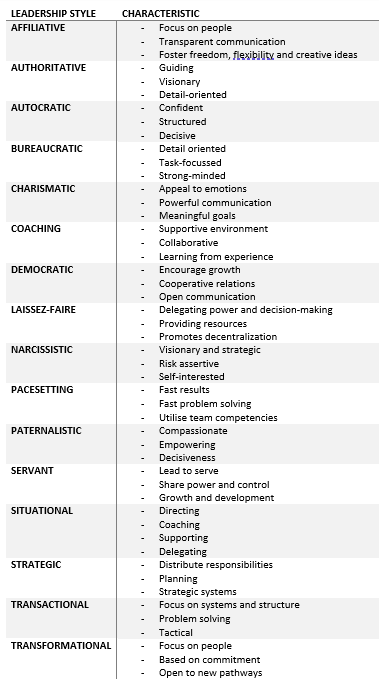Leadership styles and development
(→Leadership styles) |
(→Leadership Theories) |
||
| Line 18: | Line 18: | ||
== Leadership Theories == | == Leadership Theories == | ||
| + | |||
| + | {| class="wikitable" style="margin:auto" | ||
| + | |+ Caption text | ||
| + | |- | ||
| + | ! Leadership Style !! Strength !! Weakness | ||
| + | |- | ||
| + | | Affiliative || Example || Example | ||
| + | |- | ||
| + | | Authoritative || Example || Example | ||
| + | |- | ||
| + | | Bureaucratic || Example || Example | ||
| + | |- | ||
| + | | Charismatic || Example || Example | ||
| + | |- | ||
| + | | Coaching || Example || Example | ||
| + | |- | ||
| + | | Democratic || Example || Example | ||
| + | |- | ||
| + | | Laissez-Faire || Example || Example | ||
| + | |- | ||
| + | | Narcissistic || Example || Example | ||
| + | |- | ||
| + | | Pacesetting || Example || Example | ||
| + | |- | ||
| + | | Paternalistic || Example || Example | ||
| + | |- | ||
| + | | Servant || Example || Example | ||
| + | |- | ||
| + | | Situational || Example || Example | ||
| + | |- | ||
| + | | Strategic || Example || Example | ||
| + | |- | ||
| + | | Transactional || Example || Example | ||
| + | |- | ||
| + | | Transformational || Example || Example | ||
| + | |} | ||
== Leadership Development == | == Leadership Development == | ||
Revision as of 11:49, 13 March 2023
Effective leadership is critical to have successful projects. A project managers leadership style has significant impact on the project, the team’s motivation and productivity and the overall performance. Different leadership styles can be used, as not all projects are the same and the teams involved are different in every project. Self-awareness and self-reflection are some of the most important competencies a leader can have. When it comes to being a good leader, understanding one-self and understanding the people that must be lead is crucial. Being self-aware can potentially lead to understanding of behaviours and initiate useful changes to enhance leadership skills, such as learning to keep calm in stressful situations and enhance communication with stakeholders. Better communication applies to the team as well. Understanding the members of the team and knowing how to communicate with each sets a good work environment for successful projects. Leadership development is the practice of preparing and improving future and current leaders, to lead their teams efficiently and effectively. Furthermore, leadership development is an investment in the organisation’s internal growth. Good leadership leads to many different benefits, and no matter what the desired goal is, developing the necessary skills to reach the goals can significantly improve the productivity and morale towards the organisation. This article will describe applications of leadership styles in a project context. Furthermore, a discussion of the different tools that can be used for developing leadership skills. Potential limitations of the different leadership styles and tools will be discussed lastly.
Contents |
Leadership styles
Project managers are expected to be leaders, but project management and leadership are two different things. The most effective leaders are both good leaders and successful project managers. Successful project managers deliver successful projects – they develop their skills through experience in doing their type of projects. On the contrary, successful leaders are courageous, ambitious, confident, and self-aware. They continuously develop the strengths of themselves and their project teams [1], The performance of both project managers and leaders are measured in the performance of the team, making it even more important for project managers to develop leadership skills.
A leadership style refers to the approach that a manager or leader takes to provide motivation and direction to their team and achieve project objectives. There are numerous leadership styles available, each tailored to suit the leader's personal style, team dynamics, and project requirements.
However, each leadership style has its own set of strengths and weaknesses that can influence its effectiveness in various scenarios. Therefore, when choosing a leadership style, it is essential to consider the specific situation and context, such as the project type, team culture, and individual characteristics of the team members. The selected leadership style may need to be adjusted depending on these factors to ensure optimal outcomes.
Leadership Theories
| Leadership Style | Strength | Weakness |
|---|---|---|
| Affiliative | Example | Example |
| Authoritative | Example | Example |
| Bureaucratic | Example | Example |
| Charismatic | Example | Example |
| Coaching | Example | Example |
| Democratic | Example | Example |
| Laissez-Faire | Example | Example |
| Narcissistic | Example | Example |
| Pacesetting | Example | Example |
| Paternalistic | Example | Example |
| Servant | Example | Example |
| Situational | Example | Example |
| Strategic | Example | Example |
| Transactional | Example | Example |
| Transformational | Example | Example |

